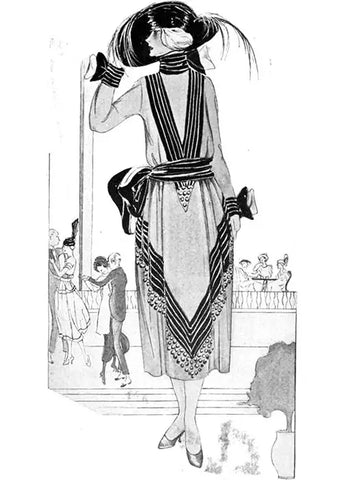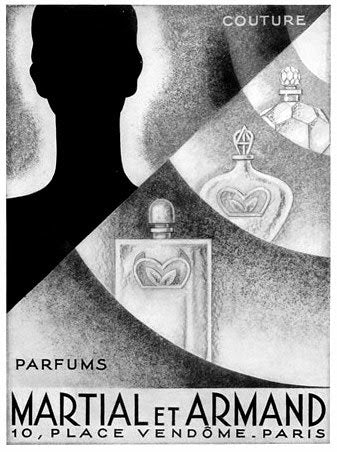This is part two of our posts on Parisian fashion designers of the 1910-20s period. Read the first part HERE.
Margaine Lacroix

Jeanne Margaine-Lacroix was born in Paris in 1868. Her mother Armandine was a couturier who founded Maison Margaine in 1889. It obtained a gold medal at the World’s Fair in Paris in 1889.

When her mother died in 1899, Jeanne took over ownership of the business and renamed it Maison Margaine-Lacroix. It was a member of the Collectivité de la Couture which exhibited models in the Salon des Lumières at the 1900 Exposition Universelle in Paris.

The house popularised the Tanagra dress style, which was worn with a modified corset and and the ‘Sylphide’ dress which had a built-in stretchy elastic lining, allowing it to be worn without a corset. Jeanne worked with manufacturers to produce soft knit fabric and front-lacing undergarments that allowed the wearer greater freedom of movement. She wanted women to look more natural and her designs caused a stir at the time as they revealed the true shape of the wearers body. First mentioned in 1899 in L’art et la Mode.

Jeanne said that “I have been patiently at work for years, educating the public to what women’s dresses really should be….only two garments cover the body- there is first a tight elastic silk jersey….. the outer garment is made to serve as its own corset, the bodice being strengthened with a little whalebone, not enough however to destroy its suppleness”.
Her designs were pre-cursors of modern shapewear.
Three of her models appeared at Longchamps racecourse in 1908 wearing her free-line gowns which the press dubbed ‘the Directoire gown’. The models appeared partially naked to the sensibilities of the time without ‘proper’ corsetry. The gowns were also spilt to the knee and clung to the body as a bias-cut garment would; The first body-con dress. One of the models was immediately offered a contract by the director of the Moulin Rouge. The new style was quickly adopted by famous personalities such as British socialite Lillie Langtry.
It is astonishing how much influence she had on fashion at the time for her name to have become largely forgotten.


‘The sensational directoire style apparently caused a near riot in Chicago, when “a pushing, scrambling mob of 10,000 persons” gathered to watch a “pretty girl in a directoire gown” who had accepted a bet of $500, walk through the town clad in the new fashion! The incident may in fact have happened during the shooting of “The Directoire Gown,” a film made in Chicago in 1908 that featured a similar scene and evidently aimed to cash in on the notoriety of the new fashion.’ - taken from rbkclibraries Wordpress.
Jeanne went on to present wide-legged trousers for women in 1910, months before Paul Poiret.
The 1919 silent film La Cigarette, directed by Germaine Dulac, a female French film-maker, starred Andrée Brabant dressed by Jeanne.


She passed away in 1930, a key figure in bringing about the drastic change in women’s fashion that saw the removal of the tightly corseted figure in favour of comfort and a more natural line that twentieth-century women embraced.

We scored an absolutely exquisite 1920s gold beaded jacket by none other than the house of Margaine-Lacroix at auction this year.
Louise Chéruit

Born Louise Lamaire in 1866, she received her early professional training in dressmaking in the late 1880s with Raudnitz & Cie.
She helped launched Paul Poiret's career by buying a collection of some of his early work in 1898. Louise and her sister took over the Raudnitz firm by 1905 and renamed it Chéruit in 1906.
In 1910, one Paris reporter wrote glowingly, "With taste, so original, so fine, and so personal, Madame Chéruit has placed her house of fashion at the first rank, not only in Paris, but in the entire world."

In 1912, Mme. Chéruit signed a contract to collaborate with Lucien Vogel to produce the fashion magazine, La Gazette du Bon Temps. Six other top Paris designers - Georges Doeuillet, Jacques Doucet, Jeanne Paquin, Paul Poiret, Redfern, and the House of Worth - also joined the project. Mme. Chéruit had a special affection for the artistic style of Pierre Brissaud, and he created most of the illustrations of her work that appeared in the pages of the magazine.

Mme Chéruit’s aesthetic was traditionally feminine, incorporating soft fabrics, pastel colors and rare embroideries, but she was innovative in line and cut. Her walking suits were also staples in the mid teens.
The house remained fully operational during WWI. However, an espionage scandal caused her go into seclusion in 1914 and her house was acquired by its directors in 1915.
Fascinated by the effect of light on fabric, Chéruit and her designers worked with taffeta, lamé, and gauze, and followed the latest trends in art, for instance hand-painting Cubist designs on dresses, coats and other articles of apparel. These striking creations drew the attention of silent film stars, such as Jeanne Eagles.

As tastes changed in the 1920s, she retired from the company in 1923. The company continued to produce beautiful jazz age gowns without her until 1930.
Her name is also frequently associated with the fashion photography of Edward Steichen whose favourite model, Marion Morehouse, often wore gowns from the house of Chéruit for Vogue magazine in the mid to late 1920s.

The design firm's continued popularity was reflected in iconic references in Evelyn Waugh's 1930 bestseller Vile Bodies.
Elsa Schiaparelli took over the premises in 1935.
Louise passed away in 1955.
Jeanne Adele Bernard/ Jenny

Jeanne, also known as Jenny Sacerdote or Madame Jenny, was born in France in 1868. She had studied academics and did not turn to fashion until the age of 39 when she started working as a sales girl at Bechoff-David.
In 1909, she married Emil Sacerdote and opened her first shop.
She said of her entry into the fashion world: “I was not even born in the business, and I have never been a working girl. In fact I studied to become a history professor. I was utterly bored by it all, so I just let it drop and entered a big dressmaker’s to learn the trade. One day I set myself up in business, and that’s all.”

Her style often employed a straight silhouette with ample use of trimmings. She developed what became known as 'the Jenny neck', which was a boat neck, in 1911. She is most famous for her simple 'little grey suit', which debuted in 1915. By that year, she had a large premises on the Champs-Elysées with 22 workshops, a restaurant, and showrooms decorated by acclaimed designer Robert Mallett-Stevens. It was the first purpose built fashion house in Paris. Her designs were copied overseas by people like Elizabeth Seymour Handley in London.
Her favourite colours for designs were shades of dull pink: old rose, ash pink, and orchid pink are common descriptions alongside red and green and varying shades of brown.

Jenny turned a huge profit during WWI, becoming the most imported Parisian label in America.

The designer was inherently chic and moved in Paris' café society with ease as well as hosting large parties at her castle in the countryside, regularly appearing in the papers.

Sacerdote became a Chevalier of the Legion of Honneur in 1926, for services to fashion. She was only the second woman to be granted this honour (the first being Jeanne Paquin).

Her house closed in 1940 during WWII and did not reopen after. She died in Nice in 1962 at age 94.
Jane Régny

Jane Régny was the designer pseudonym of tennis player Madame Balouzet Tillard de Tigny. She and her husband operated the label in the 20s and 30s, specializing in sports clothing. As a sportswoman herself, Régny was able to design garments that would meet the requirements of her clientele. The company developed a signature textile print for Alcot Fabrics from 1926-1928.

One shopping guide said of the brand’s designer: “Jane Régny saw the inevitable conquest of her world by the new idea of sports for women of a freer life, with different demands on the couturiers”.


There were plenty of boldly labelled Jane Régny copies for sale, and patterns “in the style of “Jane Régny for home dressmaking.


Their salon was located on Rue La Boétie and was decorated with custom Art Deco furniture.
Georges Doeuillet

Georges was born in France in 1865 or 75 and went on to work as a business manager for the Callot Soeurs. He opened his own fashion house in 1900 in the Place Vendôme, the first designer to do so. He was a leader in fashion in his first ten years in business and by 1911 was made an Officer of the Legion of Honneur in recognition of his contribution to fashion.

Doeuillet designed the dresses for the first performance at the Theatre Mogador when it opened in 1913, where he showed the first cocktail dress.
Doeuillet designed highly detailed dresses of elaborate design, and was very successful throughout the first two decades of the 20th century. In 1915, he included in his collection a black velvet and taffeta dress with the newly popular tiered handkerchief hem.

Doeuillet served as the President of the Chambre Syndicale de la Haute Couture until 1915.
The French Government supported the couture "old masters" including Doeuillet during WWI. They sent dresses from their prestigious designers to demonstrate French fashion at the Panama Pacific International Exposition of 1915.
In 1917, he introduced the barrel-line silhouette.


In 1929, Doeuillet took over the house of Jacques Doucet after Doucet's death. He ran both houses until his own death in 1934.

Martial and Armand
We couldn't find out too much information about this house.

Mr. Armand established a lingerie business in 1896 in Paris and expanded into dresses in 1902. By 1906, the American press wondered who the Martial component was. There seems to have been another location in London- was Martial heading the offices in that loaction?

Names associated with the company were: Jules Renou, Elie Dupui, Marie Vallet, Walter Shyeer and Milton Abelson.
Their designs were featured in a double page spread in Vogue in 1921.


Pauline Trigére was apprenticed there in the 1920s.
A range of perfumes were released throughout the 20s.

Business continued until 1951 when the shop closed for good.


